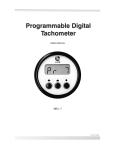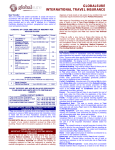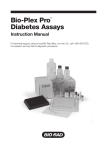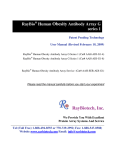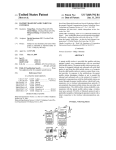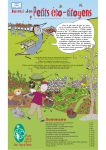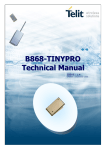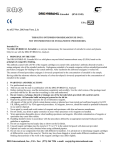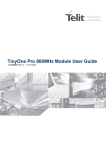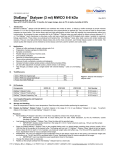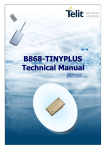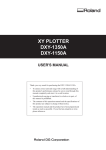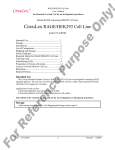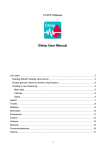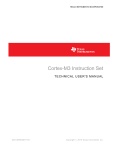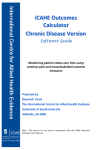Download User Manual
Transcript
B-Bridge International, Inc. esRAGE ELISA Kit User Manual UM-100901 Published 01 January 2005 Catalog # K1009-1 Manufactured by Daiichi Fine Chemical Co., LTD Distributed by B-Bridge International, Inc. See List of Components for Storage Conditions FOR RESEARCH USE ONLY esRAGE ELISA Kit User Manual Table of Contents I. II. III. IV. V. VI. VII. VIII. IX. Introduction and Protocol Overview List of Components Additional Materials Required Reagent Preparation and Storage Sample Preparation Human esRAGE ELISA Protocol Calculation of Results Troubleshooting Guide References 3 5 6 7 7 8 10 11 12 Notice to Purchaser This product is to be used for Research Purposes Only. It is not to be used for Drug or Diagnostic Purposes, nor is it intended for Human Use. B-Bridge products may not be resold, modified for resale, or used to manufacture commercial products without the express written consent of B-Bridge International, Inc. EXCEPT AS OTHERWISE EXPRESSLY SET FORTH IN THIS USER MANUAL, B-BRIDGE DOES NOT MAKE ANY REPRESENTATION OR WARRANTIES OR CONDITIONS OF ANY KIND, EITHER EXPRESS OR IMPLIED, WITH RESPECT TO THE PRODUCTS, OR INFORMATION DISCLOSED HEREUNDER, INCLUDING, BUT NOT LIMITED TO, THE IMPLIED WARRANTIES OF MERCHANTABILITY, FIT FOR A PARTICULAR PURPOSE, OR NONINFRINGEMENT OF THE INTELLECTUAL PROPERTY RIGHTS OF THIRD PARTIES. ©2002, B-Bridge International, Inc. All Rights Reserved. B-Bridge International, Inc. 2 www.b-bridge.com esRAGE ELISA Kit User Manual I. Introduction and Protocol Overview In multicellular organisms, most cellular and plasma proteins undergo a nonenzymatic glycation by the covalent binding of reduced sugars to the amino groups on proteins. A balance exists between early glycation products and non-glycated proteins during homeostasis. Under the condition of prolonged hyperglycemia as in diabetes, these early stage glycation products undergo additional chemical rearrangements to form irreversibly bound advanced glycation end products (AGE) 1, 2. AGE has been shown to be a major factor in vascular cell derangement in diabetic patients3, 4. AGE has also been implicated in Alzheimer’s Disease by the glycation of amyloid-β peptide and microtubule-associated protein tau5. The receptor for AGE (RAGE), a 45kDa protein and a member of the immunoglobulin superfamily of cell surface molecules, is found in mononuclear phagocytes, endothelium, vascular smooth muscle, and the central nervous system6, 7, 8. RAGE is a multi-ligand receptor. The most pathological consequence of the AGE-RAGE engagement is induction of oxidative stress, activation of nuclear factor kB (NF-kB), resulting in disruption of homoeostatic functions in the vasculature9, 10, 11. AGE has also been shown to up-regulate the RAGE expression in endothelial cells12. Translation of RAGE mRNA isolated from human endothelial cells revealed a novel splice variant named endogenous secretory receptor (esRAGE) which can capture AGE and neutralize the effects of AGE on cells3, 13. Endogenous secretory RAGE has been found circulating in blood and in extracellular fluids of our bodies13. The B-Bridge esRAGE ELISA Kit is designed to measure the concentration of human esRAGE in serum, plasma, and tissue culture medium. The principle of the assay is shown in Figure 1. Standards or samples and detection antibody (esRAGE antibody horseradish peroxidase conjugated) are incubated in an anti-RAGE antibody coated 96-well microtiter plate. After 16-24 hour incubation and four washing, substrate is added to each well. The plate is incubated for 30 minutes. The enzymatic reaction is stopped by the addition of stop solution and absorbance of the resulting yellow product is measured at 450 nm. The absorbance is proportional to the concentration of esRAGE. A standard curve is constructed by plotting absorbance values versus esRAGE concentrations of standards, and concentrations of unknown samples are determined using this standard curve. B-Bridge International, Inc. 3 www.b-bridge.com esRAGE ELISA Kit User Manual Figure 1. Assay Principle esRAGE antibody HRP-conjugated HRP -conjugated esRAGE E Substrate H2O2tetramethlybenzidine E Y YY E 2nd Reaction 1st Reaction E Color Development E E YYY YYY YYY YYY Anti-RAGE antibody-coated plate B-Bridge International, Inc. 4 www.b-bridge.com esRAGE ELISA Kit User Manual II. • List of Components Store all components at 2-8ºC. DO NOT FREEZE. 1 PRIMARY ANTIBODY-COATED PLATE One 96-well plate with adsorbed anti-RAGE antibody Plate is provided in a resealable foil pouch with desiccant. 1 Plate 2 DETECTION ANTIBODY esRAGE antibody-horseradish peroxidase (HRP) conjugated . SUBSTRATE 3,3’,5,5’-tetramethylbenzidine and hydrogen peroxide 1 Bottle (11 ml) 4 STOP SOLUTION 1 M sulfuric acid 1 Bottle (15 ml) 5 BUFFER Phosphate buffered saline containing bovine serum albumin 1 Bottle (5 ml) 6 esRAGE STANDARD Human esRAGE, 1.6 ng 1 Bottle (lyophilized) 7 5X WASH SOLUTION Phosphate buffered saline with Tween 20 2 Bottle (50 ml each) 3 1 Bottle (15 ml) MSDS forms are available on our website—please visit www.b-bridge.com B-Bridge International, Inc. 5 www.b-bridge.com esRAGE ELISA Kit User Manual III. Additional Materials Required The following materials are required, but not supplied: • Graduated cylinder • Micropipette(s) and disposable pipette tips • Null strips for 96-well plate • 96-well plate or manual strip washer • Paper towels or absorbent paper • Plate reader capable of measuring absorbance at a wavelength of 450 nm (reference filter at 650 nm, optional) • Well-closed containers such as microtubes (1.5 ml or more in capacity) • Refrigerator, 2-8ºC B-Bridge International, Inc. 6 www.b-bridge.com esRAGE ELISA Kit User Manual VI. Human esRAGE ELISA Protocol Note: Allow all reagents to come to room temperature (20-30°C) prior to the start of the assay and prepare 1X Wash Solution and esRAGE Standards as described in the previous sections. 1. Remove Primary Antibody-Coated Plate from its foil pouch. Remove any unneeded strips from the plate frame, reseal them in the foil pouch, and return the foil pouch to 2-8°C. If a 96-well plate washer is used, the plate frame should be completely filled with wells by adding as many null strips as necessary. Identify well position(s) for each sample on a data sheet or plate map. 2. Add 100 µl of esRAGE antibody HRP-conjugate to the appropriate number of antibody-coated wells. 3. Add 20 µl of assay standards (0, 0.05, 0.1, 0.2, 0.4, 0.8, 1.6, 3.2 ng/ml) or sample to the plate and mix well by pipetting. All assay standards and samples should be run in duplicates. Every plate must include the assay standards to properly correlate the sample readings. 4. Cover plate(s) securely with a plate sealer and incubate at 4-10°C for 16-24 hours. The plates should not be agitated or rocked during the incubation period. 5. Aspirate the reaction mixture from each well. 6. Wash each well with 350 µl of 1x wash solution. 7. Aspirate the wash solution 8. Repeat steps 6 and 7 three times for a total of 4 washes 9. Invert the plate and gently tap on a clean absorbent towel to remove residual droplets of wash solution. 10. Dispense 100 µl of substrate into each well. 11. Avoid exposing the microtiter plate to direct sunlight. Covering the plate with aluminum foil is recommended. Incubate at 20-30°C for 30 minutes. 12. Add 100 µl of stop solution to each well. 13. Read the plate within 30 minutes after stopping the reaction. The plates are measured at wavelength 450 nm. The recommended reference wavelength is 630 nm. B-Bridge International, Inc. 8 www.b-bridge.com esRAGE ELISA Kit User Manual Figure 2. Flow Chart of Assay Anti-RAGE Antibody-Coated Plate Standard and Sample Dilutions esRAGE Antibody HRP- Conjugated Standards or Samples 100 ul 20 ul Incubate 4-10OC, 16-24 hours Wash (4 x 350 ul) Substrate 100 ul Color development 20-30OC, 30 minutes Stop Solution 100 ul Read Absorbance at 450 nm B-Bridge International, Inc. 9 www.b-bridge.com esRAGE ELISA Kit User Manual VII. Calculation of Results 1. Subtract the mean absorbance value of the 0 ng/ml blank from each mean absorbance value of the standard series and samples tested (Net Absorbance). 2. Plot the log of known concentrations of each standard and the calculated Net Absorbance on the X-axis and Y-axis, respectively. Fit an appropriate regression curve to the plotted points. 3. Determine the esRAGE concentrations of the samples by interpolation of the regression curve formula. 4. If samples were diluted, then concentration calculations must be multiplied by the appropriate dilution factor to obtain the correct results for the undiluted samples. Figure 3. Typical Standard Curve Standard Curve OD at 450 nm 3 2 1 0 0.11 0.23 0.45 0.9 1.8 3.6 MMP-1 (ng/ml) B-Bridge International, Inc. 10 www.b-bridge.com esRAGE ELISA Kit User Manual VIII. Troubleshooting Guide Troubleshooting Guide 1. Lack of signal or weak signal in all wells Possible explanations: • • • • 2. High signal and background in all wells Possible explanations: • • • 3. Improper or inadequate washing; be certain that all wash volumes and repetitions were correct. Improper dilution of detection antibody. Overdeveloping; decrease the incubation time before the Stop Solution is added. High background in sample wells only Possible explanations: • • 4. Omission of a reagent or a step. Improper preparation or storage of a reagent. Assay performed before reagents were allowed to come to 20-30°C. Plate reader did not perform well. Sample concentration was too high. Improper dilution of detection antibody. Weak signal in sample wells only Possible explanations: • • Sample concentration was too low. Improper dilution of detection antibody. B-Bridge International, Inc. 11 www.b-bridge.com esRAGE ELISA Kit User Manual IX. References 1. 2. 3. 4. 5. 6. 7. 8. 9. 10. 11. 12. 13. Brownlee, M, Cerami, A, and Vlassara, H. Advanced glycosylation end products in tissue and the biochemical basis of diabetic complications. N. Engl. J. Med. 318:1315-1321 (1988). Harding, J.J. Nonenzymatic covalent posttranslational modification of proteins in vivo. Adv. Protein Chem. 37:248-334 (1985). Sakurai, S, Yonekura, H, Yamamoto, Y, Watanabe, T, Tanaka, N, Li, H, Azadur Rahman, A.K.M, Myint, K.M, Kim, C.H, and Yamamoto, H. The AGE-RAGE system and diabetic nephropathy. J. Am Soc Nephrol 14:S259-S263 (2003) Wautier, J.L, Wautier, M.P, Schmidt, A.M, Anderson, G.M, Hori, O, Zoukourian, C, Capron, LO, Chappey, O, Yan, S.D, Brett, J, et al. Advanced glycation end products (AGEs) on the surface of diabetic erythrocytes bind to the vessel wall via a specific receptor inducing oxidant stress in the vasculature: a link between surface-associated AGEs and diabetic complications. Proc. Natl. Acad. Sci. USA Aug 2; 91(16):7742-7746 (1994). Münch, G, Kuhla, B, Lüth, H.J, Arendt, T, and Robinson, S.R. Anti-AGEing defences against Alzheimer’s disease. Biochem. Soc. Trans. 31:1397-1399 (2003). Schmidt, A.M, Vianna, M, Gerlach, M, Brett, J, Ryan, J, Kao, J, Esposito, C, Hegarty, H, Hurley, W, Clause, M, Wang, F, Pan, Y.C.E, Tsang, T.C, and Stern, D. Isolation and characterization of two binding proteins for advanced glycosylation end products from bovine lung which are present on the endothelial surface. J. Biol. Chem. 267:14987-14997 (1992). Neeper, M, Schmidt, A.M, Brett, J, Yan, S.D, Wang, F, Pan, Y.C.E, Elliston, K, Stern, D, and Shaw, A. Cloning and expression of a cell surface receptor for advanced glycosylation end products of proteins. J. Biol. Chem. 267:14998-15004 (1992). Brett, J, Schmidt, A.M, Yan, S.D, Zou, Y.S, Weidman, E, Pinsky, D, Nowygrod, R, Neeper, M, Przysiecki, C, Shaw, A, Migheli, A, and Stern, D. Survey of the distribution of newly characterized receptor for advanced glycation end products in tissues. Am. J. Pathol. 143:1699-1712 (1993). Yan, S.D, Schmidt, A.M, Anderson, G.M, Zhang, J, Brett, J, Zou, Y.S, Pinsky, D, and Stern, D. Enhanced cellular oxidant stress by the interaction of advanced glycation end products with their receptors/binding proteins. J. Biol. Chem. 269:9889-9897 (1994). Lander, H.M, Tauras, J.M, Ogiste, J.S, Hori, O. Moss, R.A, and Schmidt, A.M. Activation of the receptor for advanced glycation end products triggers a p21ras-dependent mitogen-activated protein kinase pathway regulated by oxidant stress. J. Biol. Chem. 272:17810-17814 (1997). Schmidt, A.M, and Stern, D.M. RAGE: a new target for the prevention and treatment of the vascular and inflammatory complications of diabetes. Trends Endocrinol. Metab. 11:368-375 (2000). Tanaka, N, Yonekura, H, Yamagishi, S, Fujimori, H, Yamamoto, Y, and Yamamoto, H. The receptor for advanced glycation end products is induced by the glycation products themselves and tumor necrosis factor-a through nuclear factor kB, and by 17b-estradiol through Sp-1 in human vascular endothelial cells. J. Biol. Chem. 275:25781-25790 (2000). Yonekura, H, Yamamoto, Y, Sakurai, S, Petrova, R.G, Abedin, J, Li, H, Yasui, K, Takeuchi, M, Makita, Z, Takasawa, S, Okamoto, H, Watanabe, T, and Yamamoto, H. Novel splice variant of the receptor for advanced glycation end-products expressed in human vascular endothelial cells and pericytes, and their putative roles in diabetes-induced vascular injury. Biochem. J. 370:1097-1109 (2003). B-Bridge International, Inc. 12 www.b-bridge.com esRAGE ELISA Kit User Manual B-Bridge Products & Partnering Opportunities If you would like to receive information from B-Bridge about our products and or partnering opportunities, please contact us at Telephone: 408-735-7727 Fax: 408-735-7737 [email protected] B-Bridge product line for life-science researchers: Apoptosis Kits ELISA Kits for adipokines, esRAGE, and TAFI Transfection reagents Molecular biology reagents Electrophoresis apparatus siRNA products and design service STREX- mechanical cell stress Custom services – Antibody production Cloning Protein expression Protein-protein interaction screening Expression profiling Tissue section Immunohistochemistry B-Bridge International, Inc. 13 www.b-bridge.com esRAGE ELISA Kit User Manual NOTES B-Bridge International, Inc. 14 www.b-bridge.com esRAGE ELISA Kit User Manual NOTES B-Bridge International, Inc. 15 www.b-bridge.com esRAGE ELISA Kit User Manual B-Bridge International, Inc. 639 N. Pastoria Avenue Sunnyvale, CA 94085 USA Tel: 408-735-7727 Fax: 40/8-735-7737 [email protected] B-Bridge International, Inc. 16 www.b-bridge.com

















